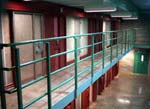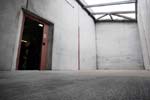
|

|
|
Home Site Search Contact Us Subscribe
|
|
|
Architects Opposing Prisons Gain Support AIASF and international groups endorse human rights changes to AIA Code of Ethics. By Raphael Sperry, AIA March 7, 2013 Not too many architects celebrate the closing of public buildings, but the supermax prison in Tamms, IL, was a special case. The prison, designed solely for long-term solitary confinement, saw its final prisoners transferred out in early January 2013, giving a cause for celebration to the families of the men held there and their supporters, including members of the non-profit Architects / Designers / Planners for Social Responsibility (ADPSR). The drawing at right shows one child’s holiday wish – that the building that had tortured his father be destroyed. There are no plans for demolition, and his father isn’t free. But he’s out of solitary and that counts for a lot.
What started out as a small online petition has been growing in impact as architects, individually and in groups, have endorsed a proposal to amend the American Institute of Architects (AIA) Code of Ethics around human rights. Launched by ADPSR in December 2012, the ethics code petition asks AIA to prohibit the design of execution chambers and “supermax” prisons used for long-term solitary isolation.
The most recent support came from the AIA San Francisco Chapter, which voted in late January to recommend the proposed amendment to the AIA National Board of Directors.
ADPSR’s campaign has received international support as well, including ARC-Peace, an affiliation of architects’ professional organizations dedicated to peace and social responsibility around the world. “It is good to see the United States joining the international consensus on ending the death penalty,” says ARC-Peace Secretary Dick Urban Vestbro of Sweden. “Speaking for ARC-Peace members in Sweden and more generally, we would be horrified to see a fellow professional designing buildings intentionally to kill people. It’s just not something we would do.”
ADPSR points to the consensus of international human rights bodies opposed to the death penalty, and a 2012 UN statement that holding people in solitary confinement for more than 15 days is a form of torture to make its human rights case. As ADPSR observes, while the AIA Code of Ethics and Professional Conduct calls on member architects to “uphold human rights in all their professional endeavors,” that language falls in an unenforceable portion of the code, and what might constitute a human rights violation by a work of architecture is completely unspecified. ADPSR’s petition asks AIA to amend the code to add an enforceable rule that buildings intended to cause human rights violations, such as death and torture (via long-term solitary confinement), should not be designed.
ADPSR is approaching additional AIA Chapters and Knowledge Communities, AIAS, and other related organizations asking for consideration of the proposed ethics code amendment. ADPSR is also actively seeking AIA members and other professionals to sign an open petition calling on AIA to make the change. “We think it’s essential for the profession, our allies, and the general public to let AIA know that we expect their leadership in this area,” says ADPSR board member Amir Price Patel, AIA. “We do hope that people who hear about the issue will go to our website, www.adpsr.org, and sign on.”
“Supermax prisons and execution chambers are cruel and unusual,” says Price Patel. “For one thing, they are very unusual in that they have no space for any kind of group social life. The entire design is structured so that prisoners stay in their cells without human contact as much as possible. Because it’s an involuntary and long-term arrangement, the deprivation of all forms of social interaction causes intense psychological harm.” Regarding the design of execution chambers, Price Patel argues, “So many innocent people have been exonerated from death row, and there is so much racial bias in who is sentenced to death in the first place, that the system should be ended whether or not you agree with ADPSR that having a government kill people is fundamentally wrong. So it shouldn’t be too much of a stretch for AIA to guarantee to the public that architects won’t put down a building where killing is intended to happen.”
Supermax prisons and execution chambers constitute a small number of projects nationally, with only one such project currently under consideration in the United States: Arizona has a proposal out for a 500-bed, $50 million expansion to its supermax prison in Buckeye. California completed a new execution chamber project in 2010. But ADPSR argues that these projects symbolize the harshest elements of the “tough on crime” paradigm that is being re-evaluated in many U.S. states in the face of budget pressures and changing public attitudes. “States all over are shelving prison construction plans and attempting to reduce their prison populations, both to save money, and because they’ve realized that locking up more people doesn’t improve public safety,” says Price Patel. “If you encounter a project like these, ADPSR would recommend that you work with the client to find a better way to improve public safety. Any number of alternative public projects would do more to reduce crime and avoid violating human rights: if your prison is overcrowded, you could build a drug-treatment center, since between 25-50% of people in prison are there for minor drug-related crimes.”
Raphael Sperry, AIA, is the current president of Architects / Designers / Planners for Social Responsibility, and a Soros Justice Fellow hosted at the University of California at Berkeley College of Environmental Design and School of Law. He is a former green-building consultant and teaches green building classes at Stanford University and California College of the Arts. |
(click on pictures to enlarge)  Courtesy Tamms Year Ten committee A child's drawing of a holiday wish at the end of 2012 that the supermax prison in Tamms, IL, that housed his father be demolished when the prison was closed in early January 2013.  Illinois Department of Corrections photo, printed in Chicago Tribune Prisoners in the Tamms supermax prison rarely left this "pod" of cells – meals and books are delivered to cells, and showers are taken in a cell at the end of tier.  Illinois Department of Corrections photo, printed in Chicago Tribune Prisoners are typically allowed no more than one hour per day in this unroofed outside space. |
© 2013 ArchNewsNow.com